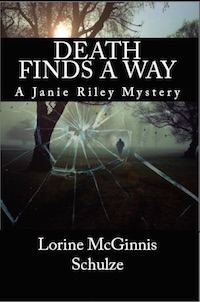
|
Olive Tree Genealogy was chosen by Family Tree Magazine as one of the 101 Best Genealogy Websites 2017! Check out the Genealogy Books written by Olive Tree Genealogy! |
 Janie Riley is an avid genealogist with a habit of stumbling on to dead bodies. She and her husband head to Salt Lake City Utah to research Janie's elusive 4th great-grandmother. But her search into the past leads her to a dark secret. Can she solve the mysteries of the past and the present before disaster strikes? Available now on Amazon.com and and Amazon.ca |
 Organize Your Genealogy in Evernote in 10 Easy Steps is a must have!
Organize Your Genealogy in Evernote in 10 Easy Steps is a must have!
|
|
Try an Ancestry.com Free Trial and Ancestry.ca Free Trial Genealogy Mystery Book! Death Finds a Way: A Janie Riley Mystery by Lorine McGinnis Schulze Janie Riley is an avid genealogist with a habit of stumbling on to dead bodies. She and her husband head to Salt Lake City Utah to research Janie's elusive 4th great-grandmother. But her search into the past leads her to a dark secret. Can she solve the mysteries of the past and the present before disaster strikes? Available now on Amazon.com and Amazon.ca Genealogy NewsletterJOIN the FREE Olive Tree Genealogy Newsletter. Be the first to know of genealogy events and freebies. Find out when new genealogy databases are put online. Get tips for finding your elusive brick-wall ancestor.
Share With OthersShare with other genealogists! Tweet this page! Tweet
Search OliveTreeGenealogy |
New Netherland, New York Genealogy
Life in 16th and 17th Century Amsterdam Holland: ChildrenChildren in Amsterdam© Cor SnabelMortality rate among young children in the 17th century was high, the poorer the parents, the smaller the families. The day laborers and the poor had the smallest families, read the highest mortality rate. Then came the farmers and shopkeepers. The landowners and the middle class had the largest families. Some reasons are obvious; bad hygiene was reason number one for infant mortality, but also negligence and ignorance were scoring pretty high. The rich and educated had all the advantages possible, they could provide a decent shelter and they could read. A very popular book about children's diseases, by Stephanus Blankaart, was written in simple, understandable Dutch and not in Latin, like every other medical book and most advise given was almost the same as today. It was not only about diseases, but also contained a lot of helpful tips, about breast feeding, nursing, toilet training, first aid, even the first games and pedagogical lessons. A short summary: cleaning the belly button of a new born with a soft, clean cloth and a little alcohol, fresh fruit and vegetables, especially rose hip. No cuddling the first minute the baby cries, no alcohol for the mother if she is breast feeding, porridge made of half water, half milk and brown bread. All these advices still stand. But a lot of children died at young age. Less than half of all new born reached adulthood, most infants died before their first birthday. The reason for that, was mostly bad hygiene, with as result diseases, which were fatal in those days. Even the “simple” children's diseases were incurable. A lot of habits disappeared during the years. One of those habits was “bakeren”. The first two months the child was wrapped in swaddling clothes from neck to feet, so it could not move. The classic reason was the correct growth of the limbs (even Aristoteles and Plato wrote about it), but it was also the best way to keep the baby calm, it was the ultimate imitation of the womb. (I remember being tucked in very tight by my parents and it felt good). By some it was seen as indolence of the mother, cartoonists in those days loved to portray those babies as packages hanging on a nail in the kitchen. This habit disappeared in the 18th/19th century, in Russia it was still common in the 20th century. Another phenomenon was the wet nurse. In history books she is always described as the “bad” woman. Normally her services were only required in case the mother could not breast feed her child and in cases of disease and death, but for a short period of time the elite had a wet nurse as a status symbol. But these aristocrat pretences were pushed aside by (even in those days) the hype of “natural” breast feeding as a must. By the time the infants were one year old and started to move around, they got a dress, even the boys. By the time the boys were six, seven years old they got man's clothes and the "lucky ones" had to go to school.
|
URL: http://olivetreegenealogy.com/
All rights reserved
Copyright © 1996-present
Contact Lorine at |